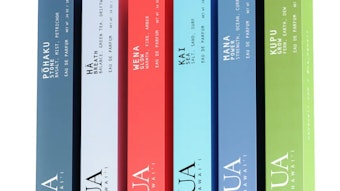!['[P]eople today own more than one fragrance and are looking to build fragrance wardrobes that fulfill different moods, times of days and occasions,' says ScentGenie co-founder Olivia Jezler. 'Just like one does not simply have five dresses all in the same color and cut. ScentGenie assists in this process of helping people find fragrances that reflect their needs but also expand their horizon so they can experience something new and exciting.'](https://img.perfumerflavorist.com/files/base/allured/all/image/2023/02/dreamstime_xxl_262771723.63ec0ef776395.png?auto=format%2Ccompress&q=70&w=700)
With about 5,000 new fragrances launched between 2020 and 2021, shoppers can find it challenging to discover a new fragrance, especially online. ScentGenie, an API that can be used on any fragrance retailer's site or internal fragrance database, translates text descriptions to fragrances.
Entering prompts such as time of day, mood or fragrance notes allows ScentGenie to reportedly surface an ideal match.
The goal is to sidestep cumbersome questionnaires or the need for expert language. (Watch the demo below.)
We recently spoke with ScentGenie co-founder Olivia Jezler about the platform's development and applications.
Q: What are the challenges of today's scent discovery tools?
Jezler: Broadly speaking there are currently two kinds of fragrance finding tools. One is a quiz, which is a multi-step process of answering questions about seasons, moods, and the ingredients one is most drawn to. The format usually asks quiz takers to choose one answer from a predetermined selection.
Another tool asks for a fragrance one likes or currently wears and it finds an alternative to this with a similar olfactory profile. The latter does not help people expand beyond their known olfactory profiles. The former is for the most part a lengthy predictable (in internet terms) process that is available on many ecommerce websites.
We are looking to address two issues. First, the time it takes and the lack of novelty when going through a quiz. Our solution is a text to fragrance finder, meaning that through any text prompt, we can lead you to a matching fragrance. Examples of prompts could be a description of what one wants to be, a mood, a place a scene or a combination of ingredients and we can pull up the fragrances that best match this description on any website or fragrance database.
Secondly, people today own more than one fragrance and are looking to build fragrance wardrobes that fulfill different moods, times of days and occasions. Just like one does not simply have five dresses all in the same color and cut. ScentGenie assists in this process of helping people find fragrances that reflect their needs but also expand their horizon so they can experience something new and exciting. It is a free form exploration which can broaden the scope of someone’s fragrance collection more easily than through a questionnaire or finding similar fragrances to the ones one already owns.
Q: What makes the ScentGenie more intuitive?
Jezler: It is a more intuitive tool because it uses text in an open-ended format. Words are what we use to converse and express ourselves with every day of our lives and people are diverse when it comes to formulating their thoughts. What we do is allow people to express in simple everyday language the way they would like a fragrance to make them feel, and ScentGenie will find them actual fragrances. What we observed when doing street surveys is that the more disconnected from fragrance people are, the easier it is to engage with a tool in this way.
One may argue that people may not know how to describe the scents they are looking for, but this comes down to how it is framed on a particular website for instance. If the website is a home fragrance site, asking people to describe what the space they are looking to scent should look and feel like, or on a fashion website that sells fragrances ask the person to describe an outfit, its colors and where they will be going could be examples of relevant prompts that a person on that website could relate to.
With the emergence of generative AI, the trend of text to image, video, music is here to stay. With time people will become more accustomed to describing what they are looking for. ScentGenie’s mission is to help people find fragrances they can fall in love with.
Q: How does the algorithm work? How was it trained?
Jezler: We use a combination of two AI models. One that generates specific data containing hidden patterns.
Q: How can the API be integrated into an existing platform at a brand, supplier, retailer, etc.?
Jezler: Our technology is a REST API that can be accessed by or integrated with any internal database or a website with the help of any IT person. It can be used in different ways by different kinds of companies. A brand could use ScenGenie to assist in the creation of fragrance briefs. They could input descriptions and find the fragrance notes that would represent these descriptions olfactively.
These notes can be used in the fragrance brief to help guide perfumers in creating a scent composition. A company with an internal database of scents can use it to find fragrances in their database based on descriptions of what they are looking for. It could make this process more intuitive and less technical. On a brand or retailer website the API can be used as a fragrance finder for an end consumer to find a fragrance based on a text input.
It can create a new form of engagement on a site that is fast, open to diverse ways of expression and solves the problem of discovering new fragrances online.










